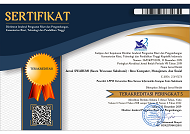Peningkatan Algoritma Naïve Bayes Menggunakan Algoritma Genetika Pada Klasifikasi Bakteri
Abstract
Full Text:
PDF (Bahasa Indonesia)References
Berrar, D. (2018). Bayes Theorem and Naive Bayes Classifier. Elsevier pp 403-412.
Consulting, A. (2019, November 08). Floydhub. Retrieved from Floydhub: https://blog.floydhub.com/naive-bayes-for-machine-learning/
Geeksforgeeks. (2020, May 15). Geeksforgeeks. Retrieved from Geeksforgeeks: https://www.geeksforgeeks.org/naive-bayes-classifiers/
Kompas. (2020, Oktober 05). Skola. Retrieved from https://www.kompas.com/skola/read/2020/10/05/194554769/klasifikasi-bakteri?page=all
Oliveira, J., & Reygaert., W. C. (2021, March 29). Gram Negative Bacteria. Retrieved from ncbi: https://www.ncbi.nlm.nih.gov/books/NBK538213/
Prevention, C. f. (2021). Centers for Disease Control and Prevention. Retrieved from https://www.cdc.gov/hai/organisms/gram-negative-bacteria.html
ymeric Vi ́e, A. M. (2021). Qualities, challenges and future of genetic algoritms: a literature review. Stanford University.
Zhang, H. (2004). The Optimality of Naive Bayes. Proc. FLAIRS.
DOI: https://doi.org/10.31294/swabumi.v9i2.11217
INDEXING

P-ISSN : 2355-990X E-ISSN: 2549-5178













